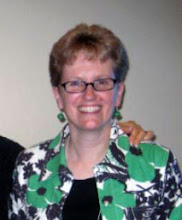
During Autism Awareness Month I have invited some of my friends who know autism far better than I do to post on my blog. The following is an interview with my friend and fellow Partners in Policymaking graduate, Julie Buick. Julie graciously spent a couple of hours this week regaling me with stories about herself, her family, her thoughts on Autism and the importance of community.
Tell us about yourself and your family:
I'm a mom. A wife, a mom and an advocate. I have 3 children: a 13 year old daughter, and 2 sons who are 9 and nearly 6 years old.
And we can't forget my husband, Bill. He's my rock! We have been together for 19 years!
My 2 boys both have Fragile X and Autism. Though they have the same diagnosis, they are completely different. One of them has issues with OCD, stimming, sensory processing disorder and lots of allergies--the other has different symptoms and needs.
Autism is the fastest growing developmental disability with--as yet--no known cause or cure. It affects 1 in 150 children. A new case is diagnosed every 20 minutes. This year there will be more children diagnosed with autism than AIDS, diabetes and cancer combined.
What do you want folks to know about?
I think the most important thing is the community and belonging. We want a community that will accept and welcome our boys and treat them like we do. We aren't going to be around forever--the community needs to be ready.
We work toward inclusion for both of our boys. They go to different schools and they are progressing toward inclusion. Last year my older son was in a situation where his classroom was "in" a school, but not part of it at all. This year is different. This year his classroom "belongs" to the school--kids say "hi" and spend time with him. He is so much more excited to be there--he walks taller. His team and their faith in him make all the difference.
I do a lot to help get the community ready--for my kids, and for all kids with all disabilities. I give talks to teachers and schools and at local colleges about disability awareness and autism. I talk about individualizing, having a can-do attitude. If I can just educate people I can take the fear out of the unknown.
I tell them that for us autism is just a label for services. We don't deal with autism at home. We just accept our kids for who they are.
I think accepting them is key. People always ask me how I cope and I tell them I don't. It's not "coping" if you accept your children. We definitely do different things for our kids than we would if they didn't have autism but it's because 'Bobby needs this' or 'Billy likes that,' or ' Katherine wants something else.' Every parent and every child wants or needs different things in any family. That isn't "coping," it's parenting!
I don't have trouble with "coping." I do have trouble finding enough time to do all the things I want to, but everyone says that!
What is the role of advocacy?
Advocacy is crucial--and it isn't a coping skill either! Advocacy is not a choice--it is the way you get everything, change everything, and make things work.
All parents advocate for their kids at some point. It's just what you do,
I know you always have lots going on--what are you working on lately?
You have to understand that I do take on a lot because I CAN. Not everyone can or wants to do all this depending on their life and their child, what's going on at home, etc.
I have great support at home--my husband enjoys being at home with the kids and supports my efforts.
I worked overnights for years so I would be home during the days for meetings and such. I still work for the same agency, but now I work at the Pieters Family Life Center which is a community center (totally inclusive!) In my job I get to run SibShops, a Spectrum Family Support Group and more.
Outside of work, I am:
• a presenter with The Advocacy Center providing disAbility awareness presentations in our community through the speakers bureau,
• Vice President of Operations for UNYFEAT (Upstate New York for Effective Autism Treatment which is the largest not-for-profit-501(c)3 in the Rochester area) Right now we are working to bring the nationally known organization Lose the Training Wheels to Rochester for a clinic this summer.
• Autism Speaks Chapter Advocacy Chair for Upstate NY region is yet another hat that I wear and a very important one. My Autism Speaks hat is the one which helps get much needed money for research.
• Training for a 10k run!
Autism costs our nation 90 billion a year and that is expected to double within the next decade. Our communities and our nation cannot afford NOT to know about Autism.
We need to raise awareness, find answers through research and provide appropriate educational services to teach life skills so that our kids become productive, healthy, happy adults, working, playing and living in our communities.
Now is the time to make a difference!
Any closing words?
I love this quote:
Never doubt that a small, group of thoughtful, committed citizens can change the world. Indeed, it is the only thing that ever has. - Margaret Mead












